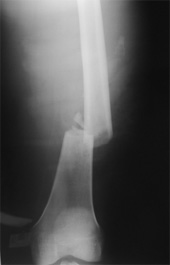December 11th, 2011 by admin in Health Tips, Quackery Exposed
No Comments »

There’s an old saying in medicine: “Use the new medicine while it still works.” This is more than just a cute quip. The saying encompasses a few different phenomena. When a drug is tested on a few thousand people, the luck of the draw may show a greater effect than would be seen in a larger, more diverse population. Also, less common side effects will become more evident in a larger sample. Once several million people take the drug, it may turn out that the drug isn’t as spectacular in a large, diverse population, and that certain side effects, though rare, are serious.
This is one of the reasons I’m a very conservative and skeptical physician. Today’s miracle drug may be tomorrow’s Vioxx. Less conservative doctors may make much more enthusiastic recommendations. I found one physician promoting pomegranate juice for rheumatoid arthritis (or at least linking to the article on Joe Mercola’s site without comment). It sounds harmless enough, but what’s the evidence? (You can hunt for the page yourself; I’m not linking to Mercola.)
The statement is based on a pilot study out of Israel consisting of data from six patients. The measures used seem quirky, but are irrelevant anyway. There are no conclusions that can be drawn from such a small sample. Despite this, the authors conclude (and Mercola and the doctor who posted the link presumably endorse) that, “Dietary supplementation with pomegranates may be a useful complementary strategy to attenuate clinical symptoms in RA patients.”
Really? Based on what? Read more »
*This blog post was originally published at ACP Internist*
September 19th, 2011 by Toni Brayer, M.D. in News
No Comments »

 I was lucky enough to see Venus Williams play her first professional tennis match when she was a teenager. It was obvious she was something special and her coach-father said “If you think she’s good, wait until you see her little sister.” (Serena Williams).
I was lucky enough to see Venus Williams play her first professional tennis match when she was a teenager. It was obvious she was something special and her coach-father said “If you think she’s good, wait until you see her little sister.” (Serena Williams).
Venus and her sister, Serena have dominated women’s tennis over the past decade but she is currently sidelined with a diagnosis of Sjogrens Syndrome. (pronounced Show-grins). It is a chronic auto-immune disorder where white blood cells (immune function cells) target the body’s moisture-producing glands. Symptoms include dry eyes, dry mouth, extreme fatigue and joint pain. Sometimes it co-exists with other auto-immune diseases like thyroid disease or rheumatoid arthritis.
Symptoms can wax and wane and getting the right diagnosis can take time. I can imagine Venus going to her doctor and complaining of fatigue and dry mouth. Considering her athletic schedule, she was probably told to get some rest and fluids. The diagnostic key should have been Read more »
*This blog post was originally published at EverythingHealth*
August 9th, 2011 by RamonaBatesMD in Opinion, Research
No Comments »

Recently I gave in and went to see a rheumatologist after more than 3 months of intense morning stiffness and swelling of my hands (especially around the PIPs and MCPs) and wrists which improved during the day but never went away. It had gotten to the point where I could no longer open small lid jars (decreased strength), do my push-ups or pull ups (pain and limited wrist motion), and OTC products (Tylenol, Advil, etc) weren’t working. I can’t take Aleve due to the severe esophagitis it induces. I didn’t want to write a prescription for my self-diagnosed (without) lab arthritis.
BTW, all the lab work came back negative with the exception of a slightly elevated sed rate and very weakly positive ANA. The rheumatologist was impressed with the swelling, pain, and stiffness and was as surprised as I by the normal lab work. He thinks (and I agree) that I am in the early presentation of rheumatoid arthritis. He wrote a prescription for Celebrex and told me to continue with the Zantac I was already taking (thanks to the Aleve). The Celebrex is helping.
So I was happy to see this article (full reference below) come across by twitter feed. H/T to @marcuspainmd: Useful review of NSAIDs effects & side effects for arthritis pain: Read more »
*This blog post was originally published at Suture for a Living*
June 30th, 2011 by Paul Auerbach, M.D. in Health Tips
No Comments »

 My 86 year-old mother, who is generally in good health, slipped and fell recently and suffered a fractured femur. She was unfortunate to have suffered the accident, but had the good fortune to be discovered quickly, treated promptly and well by the paramedics who responded to her, and then to have a swift and skillful operation by an orthopedic surgeon to repair the fracture. Almost miraculously, she was standing upright (with a considerable amount of pain) the next day and had begun the rehabilitation process.
My 86 year-old mother, who is generally in good health, slipped and fell recently and suffered a fractured femur. She was unfortunate to have suffered the accident, but had the good fortune to be discovered quickly, treated promptly and well by the paramedics who responded to her, and then to have a swift and skillful operation by an orthopedic surgeon to repair the fracture. Almost miraculously, she was standing upright (with a considerable amount of pain) the next day and had begun the rehabilitation process.
At her age—indeed at any age—a fractured femur is a very significant injury. This past year, I have learned of friends and others who have suffered falls and broken their legs, ankles, or backs, as well as others who suffered “pathological fractures.” The latter group had the bones break from normal daily stresses, without a traumatic incident, because the bones were weak and/or osteoporotic. More than a few of these injuries occurred outdoors, associated with stumbles on the trail or falls.
All of this highlights features of an excellent review article that was published this past year in the New England Journal of Medicine. Authored by Murray Favus, MD, it is entitled “Biphosphonates for Osteoporosis” (New England Journal of Medicine 2010;363:2027-35). Anyone who is contemplating taking or administering this therapy would benefit from reading this article. Read more »
This post, Osteoporosis Treatment With Bisphosphonates: Is Exercise Good Or Dangerous?, was originally published on
Healthine.com by Paul Auerbach, M.D..
May 21st, 2011 by PJSkerrett in Health Tips
No Comments »


Many Americans are remarkably unaware and uninformed about arthritis, a disease that affects about one of every five U.S. adults. Arthritis runs under the public’s radar because it isn’t a killer like heart disease and cancer. Yet it can take a huge toll on the quality of life through the pain and problems it causes. Arthritis is often viewed as an inevitable part of growing old. But it isn’t—there are many things you can do to keep your joints healthy.
May is National Arthritis Awareness Month. It isn’t aimed at people with arthritis—they’re quite aware of it already. It’s for the rest of us, some of whom are unknowingly on their way to living with this condition, and others who live with, work with, or play with folks who have it.
If you have arthritis, a new Special Health Report from Harvard Health Publications called Arthritis: Keeping Your Joints Healthy, can help you manage your condition. At the link you’ll find a description of the report, table of contents, and an excerpt. If you don’t have arthritis, the Arthritis Foundation offers 10 tips for protecting your joints. These include: Read more »
*This blog post was originally published at Harvard Health Blog*







 My 86 year-old mother, who is generally in good health, slipped and fell recently and suffered a fractured femur. She was unfortunate to have suffered the accident, but had the good fortune to be discovered quickly, treated promptly and well by the paramedics who responded to her, and then to have a swift and skillful operation by an orthopedic surgeon to repair the fracture. Almost miraculously, she was standing upright (with a considerable amount of pain) the next day and had begun the rehabilitation process.
My 86 year-old mother, who is generally in good health, slipped and fell recently and suffered a fractured femur. She was unfortunate to have suffered the accident, but had the good fortune to be discovered quickly, treated promptly and well by the paramedics who responded to her, and then to have a swift and skillful operation by an orthopedic surgeon to repair the fracture. Almost miraculously, she was standing upright (with a considerable amount of pain) the next day and had begun the rehabilitation process.









